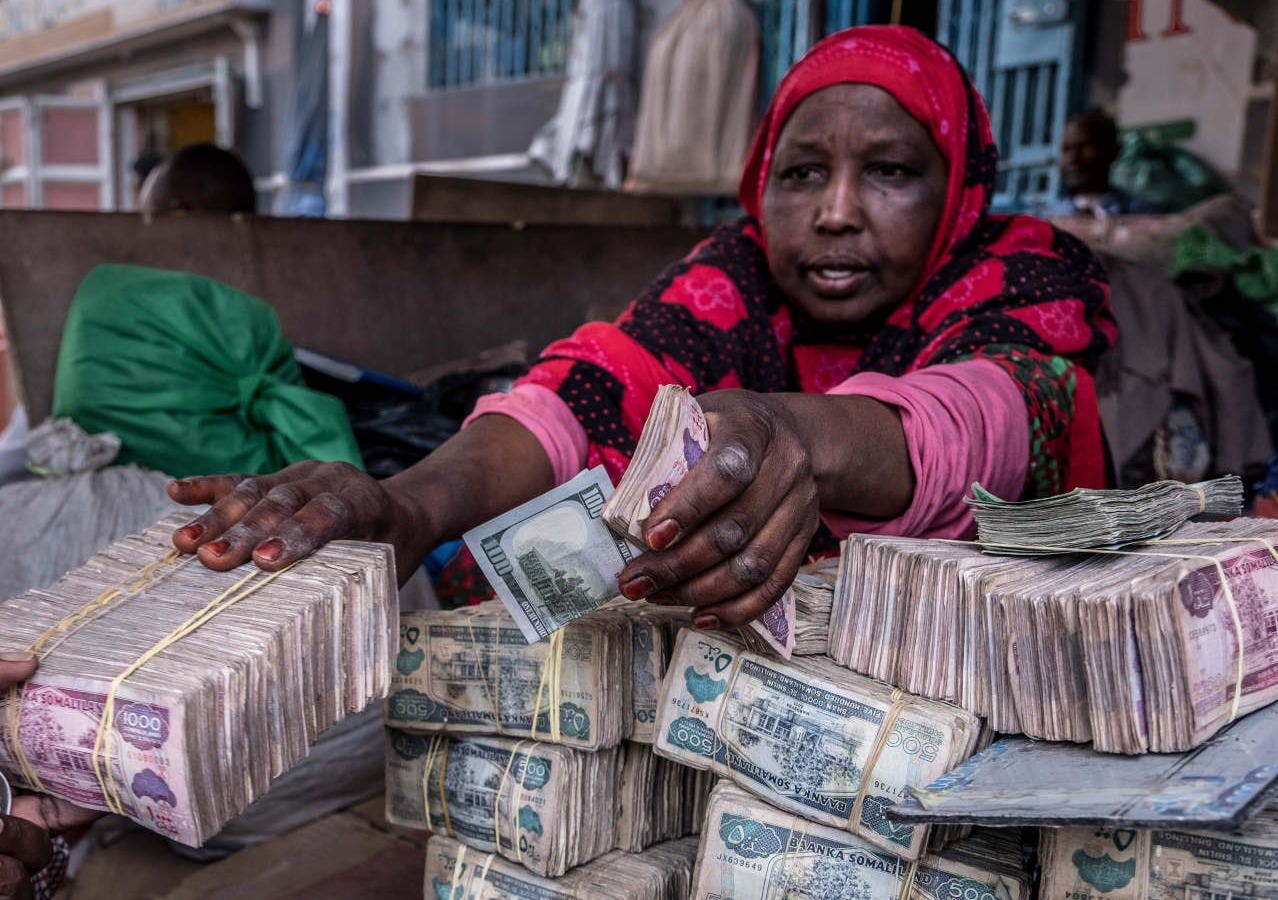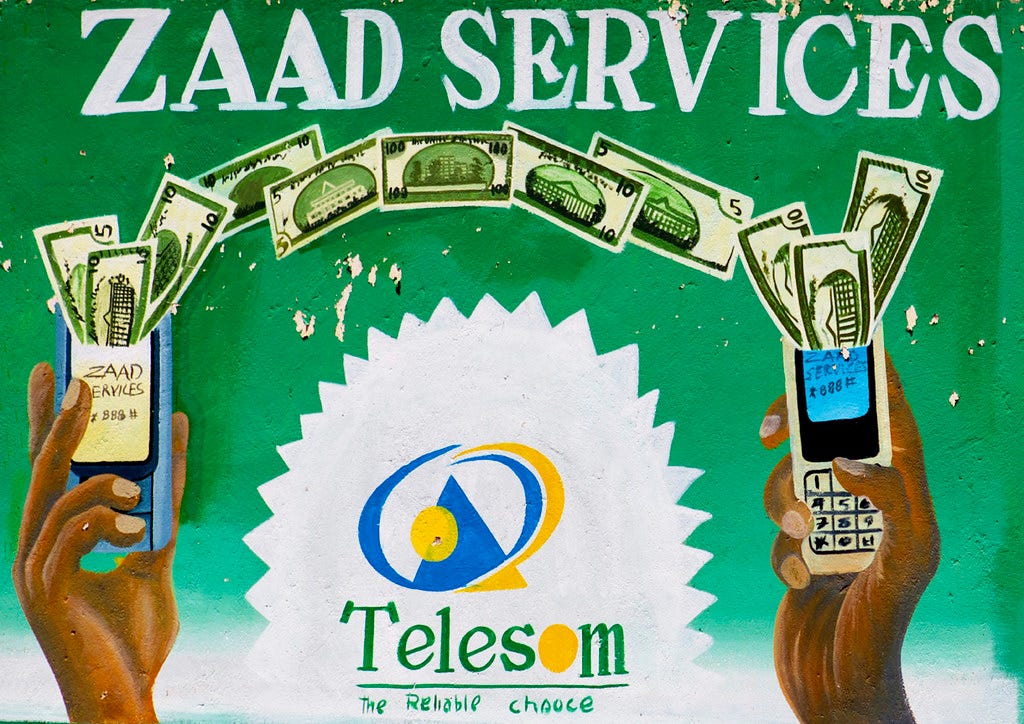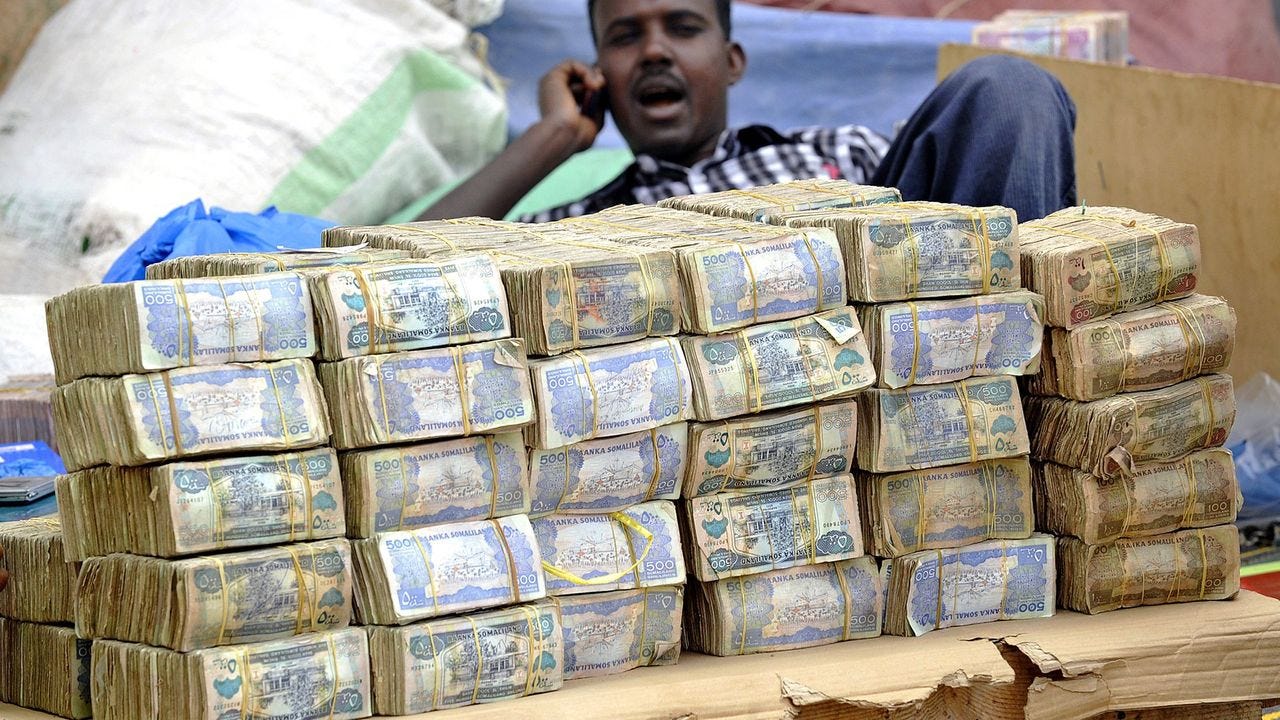In Hargeisa, Money is Measured by the Kilo
Inside the curious, chaotic, and resilient world of Somaliland’s informal money exchange market.
If you’ve ever wondered what happens when formal financial systems collapse—or never quite take root—take a walk through the streets of Hargeisa.
There, in the open-air markets of Somaliland’s self-declared capital, money isn’t just used. It’s sold. It’s weighed. It’s stacked in heaps like vegetables. And it’s handled with the kind of casual intimacy that would make most central bankers flinch.
This is not fiction. In Hargeisa, money itself is a market—tangible, visible, and oddly abundant. But to truly understand why people in Hargeisa buy and sell money by the kilogram, you have to zoom out: to history, to geopolitics, to inflation, to innovation, and to the strength of informal networks holding it all together.
Let’s start with the basics.
The Street Where Money is the Commodity
Hargeisa’s money exchange market isn’t hidden in some alley or confined to a bank lobby. It’s in the heart of the city. And it's very public.
Vendors sit cross-legged on sidewalks and plastic stools. In front of them are tables, tarps, or just the bare ground, piled high with bricks of cash—bundled, sorted, and stacked like loaves of bread.
This is not exaggeration. Physical stacks of Somaliland shillings—often in denominations as small as 500 or 1,000—tower in front of each exchanger. The volume is so immense that money is no longer counted one note at a time. It’s weighed.
It’s common to see small digital scales, like those used in grocery stores, determining the value of bundles of currency. It’s not a gimmick. It’s a response to economic reality.
Somaliland’s official currency—the Somaliland shilling—is not recognized internationally. And over the years, it has lost so much value that one US dollar now fetches roughly 8,500–10,000 Somaliland shillings. That means a $100 transaction might involve close to a million shillings in physical notes.
Carrying that in your pocket isn’t realistic. So, cash is carried in plastic bags. Wheelbarrows, even. At the market, you’ll see people lugging sacks of money—not as a sign of wealth, but as the everyday method of transaction.
Why Doesn’t Theft Happen?
You’d think a street full of currency—displayed in the open—would be a magnet for thieves.
But theft is rare. The reason is simple: the cash is nearly worthless in small quantities and extremely difficult to use in large ones without being noticed. A thief would need to carry away several kilos of money just to buy groceries.
And in a tightly knit society like Hargeisa, where everyone knows everyone else, the social cost of being caught is immense. The local culture is rooted in clan loyalty, public honor, and informal justice systems that discourage anti-social behavior.
In this strange paradox, a mountain of visible money is safer on the streets of Hargeisa than a digital wallet might be in more developed places.
A Currency Without a Country
Somaliland declared independence from Somalia in 1991 after the collapse of Siad Barre’s regime. While it has its own flag, government, and institutions, it remains unrecognized by any other country.
That also means its currency, the Somaliland shilling, isn’t backed by international reserves. No global banks deal in it. No foreign exchange reserves support it. And yet, it functions.
The economy of Somaliland is largely informal. More than 70% of the workforce operates outside of formal employment. There are few banks. Most people rely on remittances from relatives abroad, informal credit arrangements, and local exchange agents for day-to-day survival.
The Central Bank of Somaliland exists, but its control over monetary policy is limited. There’s no sovereign bond market. No international aid in hard currency. No IMF bailouts.
So, people make do. And in doing so, they’ve created one of the most fascinating cash-based systems in the world.
Remittances: The Lifeblood
If you ask any Hargeisa money changer where all this foreign currency comes from, the answer is simple: the diaspora.
Over a million Somalis live abroad—in the UK, US, Canada, Norway, and elsewhere. Every month, they send money back home. Some estimates put total remittance inflows at over $1 billion annually. That’s over 50% of Somaliland’s GDP.
This money arrives through hawala systems—informal remittance channels that operate outside the traditional banking system. Agents in London, Minneapolis, or Toronto receive dollars or pounds from diaspora workers. They contact their counterparts in Hargeisa, who then disburse the equivalent amount in Somaliland shillings.
The hawala agents need to convert foreign currency into local shillings to keep things moving. That’s where the money changers come in.
So, the piles of cash you see in the markets aren’t just for tourists or shock value. They’re a critical node in a financial ecosystem that connects families across continents.
Women at the Center
One of the lesser-known facts about Hargeisa’s economy is the critical role women play—especially in the informal sector.
Women dominate petty trade, street vending, and informal retail. Some estimates suggest that women contribute between 40–65% of Hargeisa’s revenue through these small-scale economic activities.
And many of these women rely on the money exchange market to get their daily float. Whether it’s converting $5 from a son in Finland into shillings for groceries, or exchanging 10,000 shillings for smaller notes to give change in their stalls—these markets are a lifeline.
They’re also places of negotiation, trust, and community. Everyone knows who offers fair rates, who’s reliable, and who to avoid. In a society with limited formal financial inclusion, reputation is everything.
Mobile Money: A Parallel Revolution
Even as physical cash remains dominant, Hargeisa isn’t stuck in the past.
Mobile money has taken off in a big way. Platforms like Zaad (by Telesom) and E‑Dahab (by Somtel) have transformed how people transact. Using just a basic mobile phone, a person can send money, pay bills, and shop—all without touching a banknote.
Zaad now processes millions of transactions monthly. Street vendors, taxi drivers, and even mosque donation boxes accept mobile payments.
And this shift isn’t just about convenience. It’s also about stability.
Because the Somaliland shilling is so unstable, many users keep their savings in mobile wallets denominated in US dollars. This effectively creates a shadow dollar economy—safer, more trusted, and more efficient than hauling cash.
Mobile money has also helped fight inflation. Some studies suggest that the widespread adoption of mobile payments has curbed hyperinflationary pressures by reducing physical money in circulation.
Still, not everyone has access. Older generations, rural communities, and those without mobile phones remain reliant on the cash market.
So, Hargeisa today operates on two financial systems—one rooted in cash piles and human trust, the other in SIM cards and digital ledgers. And they somehow coexist.
The Fire That Shook the Market
In April 2022, a massive fire broke out in Hargeisa’s Waheen Market—the largest commercial hub in the city.
It burned for hours. By the time it was extinguished, more than 5,000 businesses had been destroyed. Thousands lost their inventory, savings, and livelihoods. Damage was estimated at $2 billion—more than 60% of Somaliland’s entire GDP.
Many of the market’s victims were informal traders. Most were uninsured. For many, their only capital was the cash in their stalls.
The fire was a harsh reminder of the fragility of cash-based, informal economies. When there’s no digital backup, no credit system, and no insurance safety net—everything can be lost in a single night.
Recovery has been slow. Some traders rebuilt with the help of diaspora donations. Others are still struggling.
But the exchange market didn’t shut down. Vendors moved to other areas, reopened under tents, and continued trading. Money, after all, still needs to flow.
What the Central Bank is Trying to Do
In recent years, the Central Bank of Somaliland has tried to bring more regulation to the market.
They’ve licensed money changers, set maximum exchange spreads, and tried to peg the Somaliland shilling within a fixed range. In 2023, the Bank even injected $4.6 million into the market to strengthen the shilling.
They’re also encouraging the shift to mobile money and promoting financial literacy.
But their capacity is limited. Somaliland has no access to international finance, no major exports beyond livestock, and no foreign currency reserves. Most of its economic activity happens outside of any official accounting system.
So, while the Central Bank is trying to bring order, it often has to adapt to the reality on the ground, rather than dictate it.
A Market Built on Trust
At the heart of Hargeisa’s money market is something no regulation can replace: social trust.
Trust that the rate quoted is fair. Trust that the bundle of shillings you receive is complete. Trust that, even without formal contracts, your transaction is safe.
This system works not because of oversight, but because of relationships. Money changers are known in their communities. Word travels fast. A dishonest dealer can’t survive for long.
It’s a kind of decentralized accountability. And in many ways, it functions better than some formal systems in more “developed” economies.
The Bigger Picture
Hargeisa’s money exchange market may seem like an oddity—something out of a dystopian novel or a viral YouTube video.
But it holds real lessons.
It shows what people can build when formal systems are absent. It demonstrates the importance of adaptability, community, and trust in economics. And it challenges the idea that financial development must follow a single Western model.
Yes, it’s messy. Yes, it’s inefficient. But it works. And for millions of people in Somaliland, it’s the only system that does.
As mobile money grows, and as the Central Bank gains capacity, this may change. But for now, in Hargeisa, the kilo is still a unit of currency.
Would you ever trust a market where money is sold like potatoes? Or maybe the better question is—should you?











I really loved learning and reading about this. Thank you for sharing.